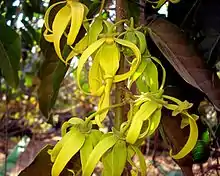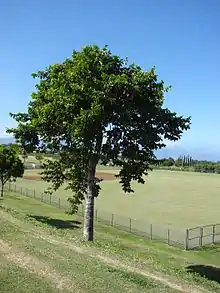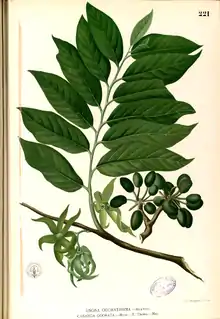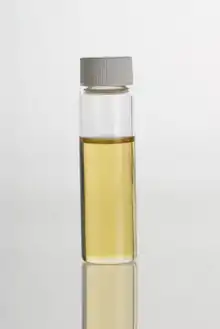Cananga odorata
Cananga odorata, known as the cananga tree, is a tropical tree that is native to India, through parts of Indochina, Malaysia, the Philippines and Indonesia, to Queensland, Australia.[1] It is valued for the perfume extracted from its flowers, called ylang-ylang /ˈiːlæŋ ˈiːlæŋ/ EE-lahng-EE-lahng[2] (a name also sometimes used for the tree itself), which is an essential oil used in aromatherapy. The tree is also called the fragrant cananga, Macassar-oil plant, or perfume tree.[3][4] Its traditional Polynesian names include Mata‘oi (Cook Islands), Mohokoi (Tonga), Moso‘oi (Samoa), Moto‘oi (Hawaii), and Mokosoi, Mokasoi or Mokohoi (Fiji).[5]
| Ylang-ylang tree | |
|---|---|
 | |
| Flowers of Cananga odorata | |
| Scientific classification | |
| Kingdom: | Plantae |
| Clade: | Tracheophytes |
| Clade: | Angiosperms |
| Clade: | Magnoliids |
| Order: | Magnoliales |
| Family: | Annonaceae |
| Genus: | Cananga |
| Species: | C. odorata |
| Binomial name | |
| Cananga odorata | |

The ylang-ylang vine (Artabotrys odoratissimus)[6] and climbing ylang-ylang (Artabotrys hexapetalus)[7] are woody, evergreen climbing plants in the same family. Artabotrys odoratissimus is also a source of perfume.[6]
Etymology
The name ylang-ylang is derived from the Tagalog term for the tree, ilang-ilang - a reduplicative form of the word ilang, meaning "wilderness", alluding to the tree's natural habitat.[8] A common mistranslation is "flower of flowers".[6]
Description

Cananga odorata is a fast-growing tree of the custard apple family Annonaceae. Its growth exceeds 5 m (16 ft) per year, and it attains an average height of 12 m (39 ft) in an ideal climate. The evergreen leaves are smooth and glossy, oval, pointed and with wavy margins, and 13–21 cm (5–8.5 in) long. The flower is drooping, long-stalked, with six narrow, greenish-yellow (rarely pink) petals, rather like a sea star in appearance, and yields a highly fragrant essential oil. Its pollen is shed as permanent tetrads.[9]
Cananga odorata var. fruticosa, dwarf ylang-ylang, grows as small tree or compact shrub with highly scented flowers.
Distribution and habitat
The plant is native to much of tropical Asia, from India to Papua New Guinea, and to Queensland, Australia.[1] It is commonly grown in Madagascar, Polynesia, Melanesia, Micronesia and the Comoros islands. It grows in full or partial sun, and prefers the acidic soils of its native rainforest habitat. Ylang-ylang has been cultivated in temperate climates under conservatory conditions.
Ecology
Its clusters of black fruit are an important food item for birds, such as the collared imperial-pigeon, purple-tailed imperial-pigeon, Zoe's imperial-pigeon, superb fruit-dove, pink-spotted fruit-dove, coroneted fruit-dove, orange-bellied fruit-dove, and wompoo fruit-dove.[10] Sulawesi red-knobbed hornbill serves as an effective seed disperser for C. odorata.[11]
Uses
The essential oil is used in aromatherapy. It is believed to relieve high blood pressure and normalize sebum secretion for skin problems, and is considered to be an aphrodisiac. The oil from ylang-ylang is widely used in perfumery for oriental- or floral-themed perfumes (such as Chanel No. 5). Ylang-ylang blends well with most floral, fruit and wood scents.
In Indonesia, ylang-ylang flowers are spread on the bed of newlywed couples. In the Philippines, its flowers, together with the flowers of the sampaguita, are strung into a necklace (lei) and worn by women and used to adorn religious images.
Ylang-ylang's essential oil makes up 29% of the Comoros' annual export (1998).
Ylang ylang is grown in Madagascar and exported globally for its essential oils.
Ylang ylang essential oil is one of the basic ingredients of macassar oil.
Ylang-ylang essential oil

Characteristics
The fragrance of ylang-ylang is rich and deep with notes of rubber and custard, and bright with hints of jasmine and neroli, thus it is sometimes described as heavy, sweet, and carries a slightly fruity floral scent. The essential oil of the flower is obtained through steam distillation of the flowers and separated into different grades (extra, 1, 2, or 3) according to when the distillates are obtained. The main aromatic components of ylang-ylang oil are benzyl acetate, linalool, p-cresyl methyl ether, and methyl benzoate, responsible for its characteristic odor.[12]
Chemical constituents
Typical chemical compositions of the various grades of ylang-ylang essential oil are reported as:[13]
See also
References
- "Cananga odorata (Lam.) Hook.f. & Thomson". Plants of the World Online. Royal Botanic Gardens, Kew. Retrieved 2019-02-11.
- OED
- "University of Melbourne: multilingual plant names database". Plantnames.unimelb.edu.au. 2004-08-05. Retrieved 2012-12-30.
- p. 12 In: Vanoverbergh, Morice (1968). Iloko-English Dictionary:Rev. Andres Carro's Vocabulario Iloco-Español. Catholic School Press, Congregation of the Immaculate Heart of Mary, Baguio City, Philippines. 370pp.
- "Cook Island Biodiversity and Natural Heritage". 2007. Archived from the original on 2 December 2005. Retrieved 18 June 2016.
- "Britannica.com". Britannica.com. Retrieved 2012-12-30.
- "Tropicos". Tropicos. Retrieved 2012-12-30.
- English, Leo James (1987). Tagalog-English Dictionary. Congregation of the Most Holy Redeemer/National Bookstore, Manila. p. 685 ISBN 9789710844654
- Walker JW (1971) Pollen Morphology, Phytogeography, and Phylogeny of the Annonaceae. Contributions from the Gray Herbarium of Harvard University, 202: 1-130.
- Frith, H.J.; Rome, F.H.J.C. & Wolfe, T.O. (1976): Food of fruit-pigeons in New Guinea. Emu 76(2): 49-58. HTML abstract
- https://www.researchgate.net/profile/Margaret_Kinnaird/publication/230142476_Evidence_for_Effective_Seed_Dispersal_by_the_Sulawesi_RedKnobbed_Hornbill_Aceros_cassidix1/links/553658d70cf218056e941e90.pdf
- Manner, Harley and Craig Elevitch,Traditional Tree Initiative: Species Profiles for Pacific Island Agroforestry (2006), Permanent Agricultural Resources, Honolulu, Hi.
- "Ylang-Ylang Essential Oil - Chemical Composition". scienceofacne.com. Archived from the original on 2012-04-14. Retrieved 2012-02-26.
Further reading
- Elevitch, Craig (ed.) (2006): Traditional Trees of Pacific Islands: Their Culture, Environment and Use. Permanent Agricultural Resources Publishers, Honolulu. ISBN 0-9702544-5-8
- Manner, Harley & Elevitch, Craig (ed.) (2006): Traditional Tree Initiative: Species Profiles for Pacific Island Agroforestry. Permanent Agricultural Resources Publishers, Honolulu.
- Davis, Patricia (2000): "Aromatherapy An A-Z". Vermilion:Ebury Publishing, London.
External links
| Wikimedia Commons has media related to Cananga odorata. |
 Data related to Cananga odorata at Wikispecies
Data related to Cananga odorata at Wikispecies